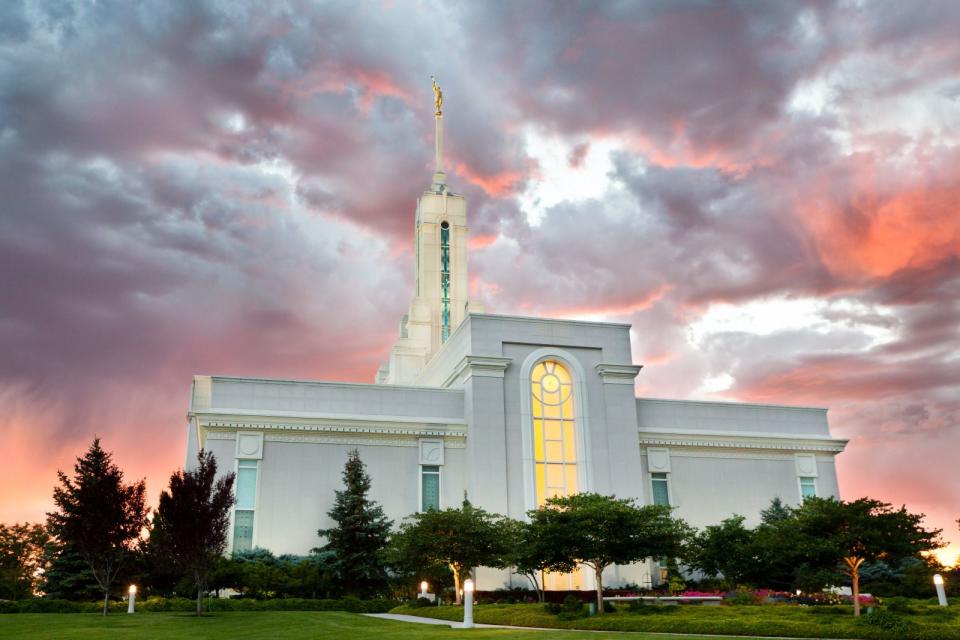Opinion: What the Wall Street Journal would have learned about temples from a Latter-day Saint like me

- Oops!Something went wrong.Please try again later.
Members of The Church of Jesus Christ of Latter-day Saints the world over rejoice when new temples are built, increasing their access to the power and peace of temple worship. Beginning with the Kirtland temple shortly after the restored church was formally organized, Latter-day Saints have made profound sacrifices to build temples worthy of their God.
Stonecutter John Rowe Moyle walked nearly 50 miles a week just to get to and from the Salt Lake City temple site, a practice he continued after losing one of his legs in his 70s. This legacy of sacrifice and devotion is the context in which Latter-day Saints pay tithes used toward temple construction. For many members, it is a privilege to contribute to these holy edifices and ratify their belief in the reality of the work done within them.
But journalists at major outlets routinely fail to give voice to the millions of Latter-day Saints who believe in the spiritual mission of the church and its leadership, relying instead on the same chorus of voices with the same unimaginative and cynical framing. Wealth can only mean greed, mistakes can only mean corruption and billions of dollars in humanitarian aid is “negligible.”
In this sense, the idea of temples as mere real estate holdings lacks significant context, to say the least. A recent article in The Wall Street Journal describing temples as “stone-clad monuments exhibiting the church’s vast and expanding wealth” reflects a culture increasingly unable to understand life except in material or commercial terms.
Yet, even the materialist take is wanting. The Church of Jesus Christ of Latter-day Saints has no paid ministry. The senior leadership of the church receives a stipend in exchange for leaving their careers and traveling the world to administrate and teach full time. And, in the case of senior church leaders, they do this until they die. Since nobody’s using church funds for their personal enrichment, what motivation could the church have for amassing such wealth? Is the church spending billions of dollars on temples in order to cheat the poor and display its wealth?
Consider that temples are not only magnificent, they are the only church buildings that are magnificent. The church also owns and operates thousands of chapels, office buildings, training centers, visitors centers, storehouses for the poor, donation centers, etc. These buildings are decidedly utilitarian. Indeed, many of the same critics denouncing the grandeur of temples also bemoan the spartan nature of chapel buildings.
Related
The truth is, temples are monuments, but not to wealth. They are beacons of light and peace, piercing clouds of cynicism, conflict and despair. They are the church’s tangible, enduring insistence that truth, beauty, love and joy are real, that God loves his children now and forever, and that these ideals are worth everything we have.
Temples are built to outlast life’s vicissitudes and to welcome Christ himself when he comes again. For those who wonder whether God is real or whether there is life after death, temples offer a stone-clad promise that the answer is a resplendent “yes.”
Anyone can see that temples are expensive, but the real question is whether they are worth it.

I’ve written before of the difficulties of my childhood. I spent a lot of my adult years feeling angry at my parents. When I married my husband in the Mount Timpanogos Utah Temple nearly 11 years ago, my parents could not attend. We held a private ring ceremony for my family, but being excluded from the temple ceremony was still a pain point. Yet, marrying in the temple ultimately brought me greater peace with my family than I could have imagined.
I thought that I was beginning a new life when I married my husband in the temple, but I wasn’t. Instead, I was plugging into the source of eternal life — and eternity has no beginning.
In Latter-day Saint temples, marriage altars are placed between two large mirrors that reflect into each other, creating a sense of infinity that stretches both before and after the bride and groom. Through the temple, the peace, love and forgiveness I’ve learned through the restored gospel not only affects my children, but extends backward in time, rewiring my connection to my parents as I’ve reimagined our life together through the lens of God’s love and mercy. I’ve found a growing sense of wholeness that fills in the empty spots of my past.
Temple worship educates and refines us in many ways, but the work of the temple ultimately centers around two objectives: connecting the entire human family to each other and connecting us all to God. The message of the temple is very simple: families can be forever. But if a family is forever, then love and forgiveness have to be, too. Temples empower us by suggesting that joy is a product of our commitment rather than our circumstances.
My love for the temple is not unique among Latter-day Saints, but these sentiments are conspicuously absent from juicy narratives about institutional greed. National news outlets rarely feature anything other than language from official church statements and critical commentary from dissidents.
If the work done inside temples — and the joy it brings — is deemed irrelevant to the discussion, then, of necessity, temples can only be expensive buildings. If the church’s significance and impact is only measurable in dollars distributed, then it’s a charitable organization rather than a church. To decide whether the church spends its money well, you must first decide what matters most. If the answer is forming eternal bonds with God and each other, then “a temple-building spree” is money well spent. If the answer is anything else, temples aren’t going to make much sense.
To sympathize with the way the church uses its resources, you first have to believe in its ultimate mission. Not everyone will, and that’s OK, but let’s not pretend their characterizations of religious matters are not influenced by these secular times. It’s worth noting, however, that when Christ visited the temple in his day, he was less interested in the cost of the building and more interested in clearing out those who were overly focused on the fleeting concerns of commerce.

